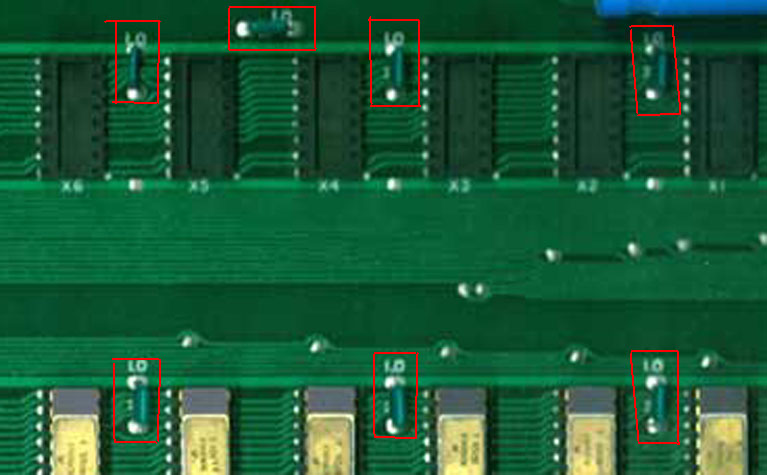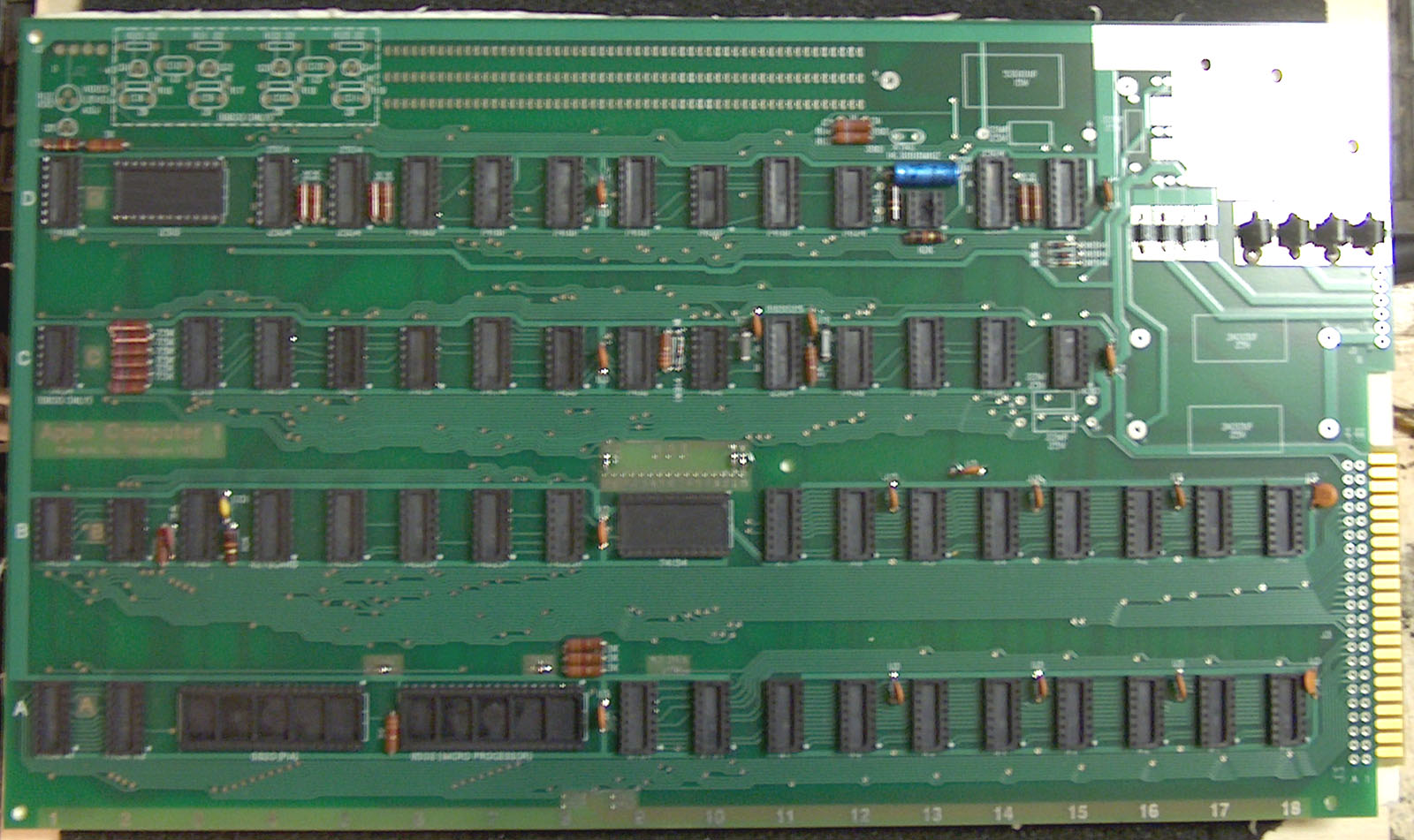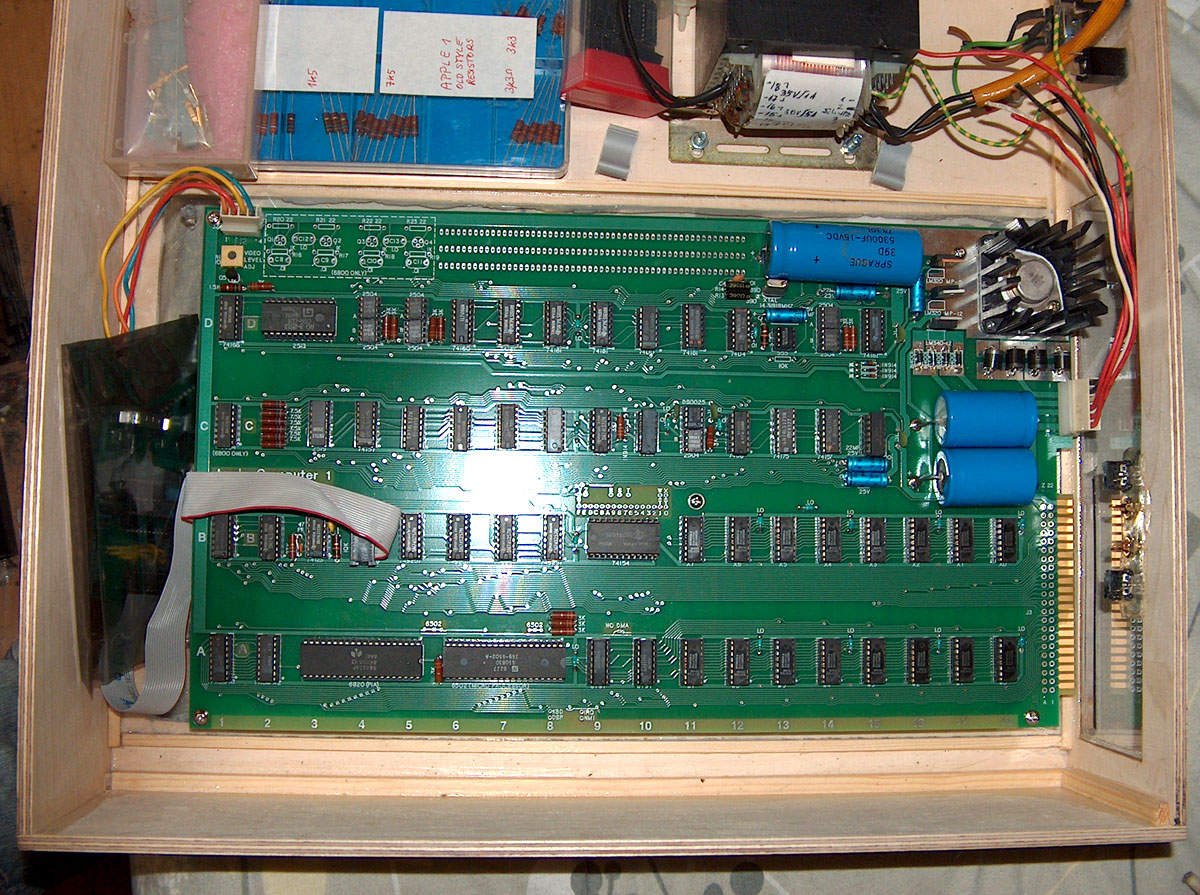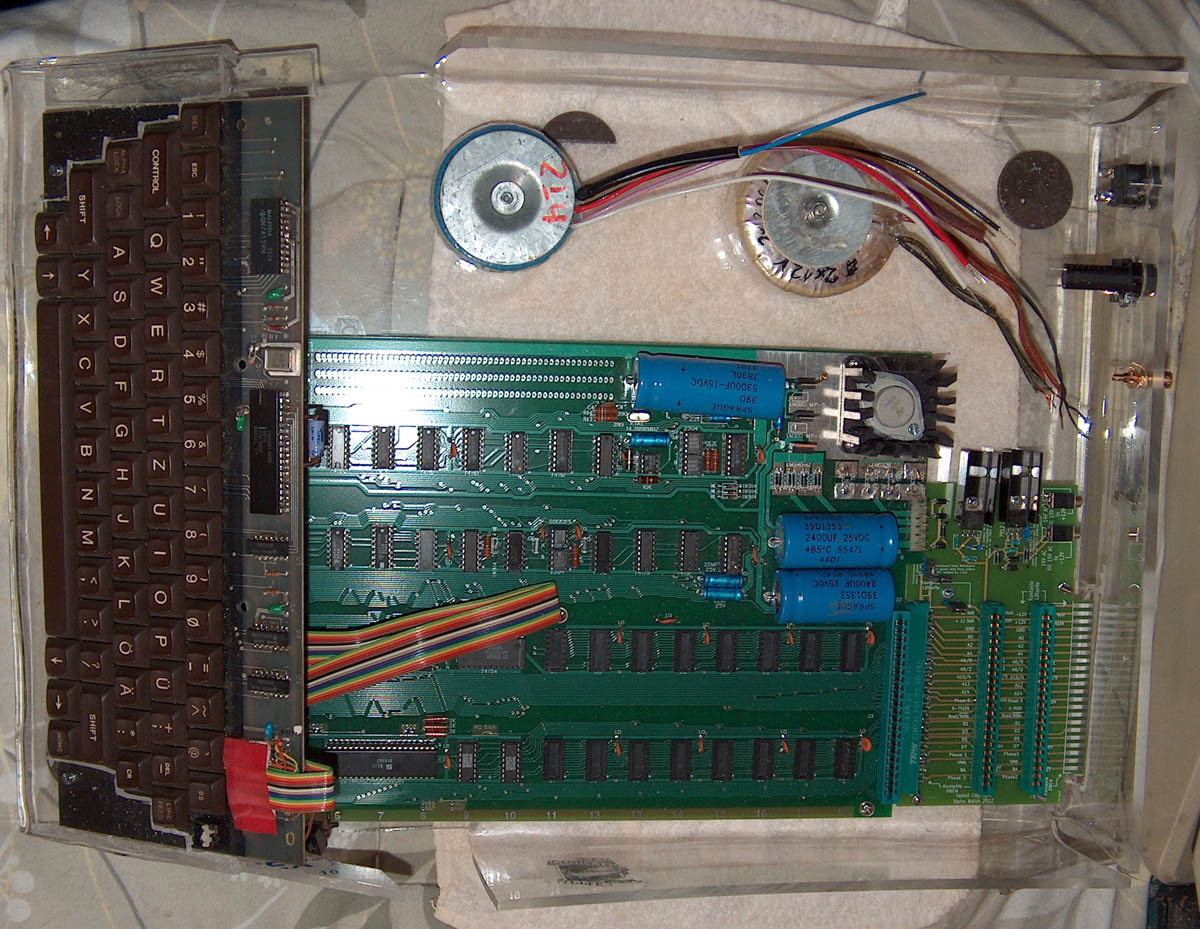|
As explained in the
Apple-1 page there have been only 250 mainboards made from
the Apple-1 and that amount had been split in two runs, of
which the
first run consisted of 100 pieces ( later called the "preNTI-version )
and the second run - which had been made by the NTI-company
and that models from
the second run have been called later the "NTI-version" of the Apple 1.
Allthough the layout of the leads and traces havenīt been changed in that
second run, the assembly and the used components did
slightly differ from the
earlier "preNTI-version". In main the decoupling capacitors on the second
run have been more modern multilayer capacitors, while in
the first run "old-
fashioned" ceramic disccapacitors have been used. Another change in
assembly had been, that the majority of the "pre-NTI" boards
still had been populated
with the white ceramic version of the 6502 CPU and the violett ceramic
version of the 6820 PIA while in the later NTI-version
nearly only the CPU and PIA
with the plastic-case had been used. And in the later NTI-version there
have been different kinds of small electrolytic capacitors
used ( ones in yellow
cases instead of the blue cased ones that have been only used in the
"pre-NTI version".
But the very first remarkable difference to common users had been the
fact that NTI set itīs factory logo below the label from
Apple Computer - a diamond
square with the letters NTI inside of it.
Differences between "pre-NTI"
version Newton 1 and the "NTI"-version of the Newton NTI
board if populated like original Apple-1
| |
"pre-NTI"
version MIMEO |
|
"NTI"-version of the
Newton NTI |
| |
ceramic CPU and
PIA |
|
plastic CPU and PIA |
| |
 |
|
 |
| |
ceramic disc
decoupling capacitors |
|
multilayer ceramic decoupling
capacitors |
| |
 |
|
 |
| |
blue electrolytic
capacitors |
|
yellow electrolytic capacitors |
| |
 |
|
 |
a remark to the pictures
above: the different shades of green silkscreen on the boards is
partially also caused by dirt or bleaching of the sun !
But the very first remarkable difference to common users had been the
fact that NTI set itīs factory logo below the label from Apple
Computer - a diamond
square with the letters NTI inside of it.
| |
 |
|
 |
| |
here the Newton-1
board without the NTI-logo |
|
and here the Newton NTI board
with the NTI-logo |
The MIMEO is ( similar to the
Newton1 ) a replication of the "pre-NTI version" of the Apple-1
out from the first run. The reproduction of the mainboard was
carried out by Mike Willegal. In fact it seems to me that the
manufacturing of the Newton1 was a reaction to the fact that
after Mike Willegal had made his ī
first limited edition of the MIMEO ( which was also a reproduction of the
pre-NTI version of the Apple-1 ) and that boards had been sold
out after very short
period of time and then for a long period the community of Apple freaks
had been quite a while waiting - the Newton1 had been made to
solve the still not
completely satisfied complaints on more replications of the Apple-1
mainboard. In the meantime Mike Willegal had quite a list of
people waiting and
has released a new run of the MIMEO.
When i decided to assemble a replication of the Apple-1 there were no
boards availiable - so i decided to stay on the list from Mike
Willegal, because he was
already collecting emails from persons wanting a board an it was
presumable that a new release would occur within reasonable
time. In the meantime i started
collecting information on the board and the history of the Apple-1 as
well as its technical details.
While collecting the technical details and reading about the tasks
performed with the Apple-1 i compared it with my detailed
knowledge on the Apple II. I have a
collection of the entire series of Apple II from early ones sold in
Europe till up to the Apple IIGS Rom 3 version. Up to my mind
the limitations of the Apple-1 had
been in majority a result from the fact that only few had been sold and
that in very short time this model had been resigned by itīs
followup - the Apple II.
If more of the Apple-1 would have been sold and if the Apple II would not
have been introduced that fast to the market - itīs my deep
believe that there would
have been more expansions developed for the Apple-1. There would have
been made a RAM-expandsioncard availiable and a slotexpansion
card to expand the
Apple-1 with at least another 2 slots. The development of such expansions
was burried by the invention and the introduction of the Apple
II that had this
additional capabilities. The 8 slots and the expandability of the RAM in
the Apple II removed this disabilities of the Apple-1 and gave
the Apple II a giant leap
ahead in the development of personal computers.
But anyhow i decided to make a step back to that time of the end of the
seventies and to develop the "missing expansions" that have not
been made in those
days and by that to permit the Apple-1 to participate from the same
success that later was granted to the Apple II. So at the same
day the boards arrived in my
home and i started hunting for the parts for the assembly i also started
with the development of the "missing links" and besides started
the development of the
slotexpansioncard, a RAMexpansion card and after few more days i also
thought it to be a good idea to make a ROMexpansioncard, that
would permit to make
basic in Eprom resident and saving time from loading basic from tape. And
because i always enjoyed making experiments with Apple II and
some kind
of prototype card i thought it might also be a nice idea to make a
prototypecard for the Apple-1 too.
In the meantime i had read all past thread related to the Apple-1
replicas and the difficulties about getting the parts for that
board. Next i contacted Unicorn
electronics, the company recommended by Mike Willegal , and claimed to
offer a complete set of parts for assembly.... and they answered
me that a lot of the
parts in the set would be quite more modern than the parts used in the
original Apple-1. While on the hunt for parts i learned a lot
about the difficulties
related to spotting of old obsolete parts from postings of corey986 at
applefritter and rather soon i had to make several experiences
of the same kind.
I canīt tell much about the market on obsolete parts in
the USA or Canada, but here in Europe i had to learn that laws
released by European Commision
áffect national laws pretty much and that sometimes such kind of laws are
made from representatives that have less knowledge upon the
results that
kind of regulations cause, than a bull knows about nuclear physics.....
the results sometimes turnout strange effects, that cause the
opposite of that what
regulation was made for.
For example in Europe the regulations to protect environment require that
only specialized companies are permitted to carry recycling
business and that
the aim should be to reach the target that electronic waste is to be
recycled in a correct manner protecting the environment.
Therefore if you enter at a Junkyard and ask if you may pick up some of
the dumped electronics, because you want to extract some
obsolete parts and want to
reuse that parts - the access to the dumped items is refused - and the
electronic waste is locked up..... but instead of recycling the
trash, they fill the stuff in
containers and ship / export that electronic waste to Ghana in Africa,
where that junk is dumped to illegal junkyards and small
children burn the trash in open
fires without any health protection and pickup the rest of metal left
after burning - but before - while burning - exploiting
dangerous and absolute toxic gases in
the entire area and poisoning the entire area with stuff like dioxin and
other lethal poisons. In the meantime in the area around Acra
and the river close to Acra
the environment has been totally damaged and poisoned. That is exactly
the opposite of the aim of the former regulation. The regulation
is totally perverted.
Just to give a short summary here a short overview of the current status
on the obsolete parts if you try to find / get them ( valued in
2 classifications -
just getting the part itself with correct datestamp or replacing it with
more modern part )
| |
part from partlist |
|
the
part itself with nearly correct datestamp |
|
replacing it
with more modern part ( later tha 1980 ) |
| |
ceramic 6502 |
|
last sell at ebay 750,00 U.S.Dollars |
|
not easy |
| |
ceramic 6820 |
|
very difficult |
|
not easy |
| |
yellow spectrol 150 Ohm trimmer |
|
impossible |
|
difficult |
| |
8 pin TI socket |
|
very difficult |
|
difficult |
| |
14 pin TI socket |
|
very difficult |
|
difficult |
| |
16 pin TI socket |
|
very difficult |
|
difficult |
| |
24 pin TI socket |
|
nearly impossible |
|
difficult |
| |
40 pin TI socket |
|
nearly impossible |
|
difficult |
| |
Mk4096 RAM chip |
|
rather expensive |
|
not easy |
| |
DS0025 clockpulse-amp |
|
very expensive ( i had
to pay nearly 48 U.S. Dollars ) |
|
difficult |
| |
2504A shiftregister |
|
difficult |
|
not easy |
| |
2519 shiftregister |
|
difficult |
|
not easy |
| |
2513 Character ROM |
|
very difficult |
|
very difficult |
| |
7450 |
|
rare and difficult |
|
difficult |
| |
7427 |
|
difficult |
|
difficult |
| |
74157 |
|
not
easy |
|
|
| |
74160 |
|
not
easy |
|
|
| |
74161 |
|
not
easy |
|
|
| |
74166 |
|
not
easy |
|
|
| |
74S257 |
|
not
easy |
|
|
| |
8T97 |
|
not
easy |
|
|
| |
"old fashioned" carbon resistors |
|
difficult |
|
not easy |
| |
14,318 Mhz clockcrystal |
|
extreme rare and difficult |
|
difficult |
| |
LM323K "Goldcap" TO3 case
5 V regulator |
|
impossible |
|
difficult |
| |
Correct AVID coolingsink |
|
very difficult |
|
difficult |
| |
5300 ĩF capacitor |
|
very expensive |
|
not easy |
| |
2500 ĩF capacitor |
|
very expensive |
|
not easy |
| |
305-044-521-201 44pin
edgeconnector |
|
very difficult |
|
rather
difficult |
| |
MMI 3601 |
|
extreme difficult ( only 1 source for programmed ones ) |
|
very difficult |
| |
MR500/A14F 3A rectifier diodes |
|
rather difficult |
|
|
| |
MPS 3704 |
|
rare |
|
not easy |
scale of difficulty:
| |
not easy |
rare |
difficult |
very expensive |
extreme rare |
very difficult |
nearly impossible |
impossible |
Just to give an impression - i
needed more than 6 months to get rather close to the original
and i spent more than 1500,00 U.S. Dollars to get
at least quite closer than if i would have purchased the parts-set from
Unicorn electronics .... starting with the fact, that my boards
are populated
with the correct TI-sockets..... and the carbon resistors in "old
fashioned" case ( with "cut-off ends" instead of the rounded
ends normal today ).
| |
here is a view to the MIMEO
board with the "on board" components soldered only: |
| |
 |
During the months i have been
hunting for the parts the most difficult parts turned out to me
to be the edgeconnector, the DS0025 and the clockcrystal.
in that period Michael Ng announced that he would launch the
manufacturing of the Newton NTI board. Because i knew that all
other replications had
been made from the "pre-NTI" Apple-1 i immediatly enlisted myself for one
of this boards. It will permit me to build up the second version
of replication
and then offer to me the possibility to compare both boards with
eachother. And after all because i decided to develop also some
expansionboards, it
would permit me to test this expansionboards on two slightly different
systems.
In the beginning when the bare PCB of the MIMEO arrived i intended to
build the replication in "old fashioned style" meaning
that i intended to make
a wooden case like it was done by most of the owner of an original
Apple-1. In the mid of December 2012 ( short after i enlisted
for the Newton NTI )
i also recieved an invitation to take part in the Vintage Computer
Festival Europe at the end of April 2013. Quite close in that
time in December Corey986
published his contribution at applefritter about making a transparent
case for his MIMEO. Although the wooden case had been prepared
allready,
i decided to delay this kind wooden case and switched my mind to instead
also make a transparent case for the Vintage Computer Festival
and by that
enable the visitors to get a complete view to the entire Board from every
angle of view. If i would build both boards in Lexan-cases it
would give the
visitors of the VCFe the chance to carefully compare both boards and also
it would permit to display a piece of histors that the Apple-1
was not only
a single first personal computer - but even that this very first piece
consisted of two different kinds of versions. The previously
planned wooden case
would have looked like that:
| |
 |
At that stage of
assembly the board still had the wrong video level adjust
resistor and the wrong rectifier diodes for the 5 volt branch.
In the following months
while getting parts that fitted closer to the original i
started to change "just working" parts against "nearly close to
original" parts and i started to make a
transparent lexancase.
| |
|
| |
 |
While designing the lexancase i
also decided to calculate the space required to integrate the
slotexpansioncard that i started planning also in December
and to present the expansioncards, if possible ( - and if the new
designed expansioncards could be completed in that short period
of time ) at the VCFe too.
At that time i already had replaced the video level adjust resistor and
the rectifier diodes in the 5 Volt branch. It was also clear
that it would never be possible to
receive, assemble and complete the ordered Datanetics keyboard and
therefor i was forced to use another keyboard and modify the
connection to march with
the requirements of an Apple-1. It was at this point also clear that i
would need to use transformers for European power source of 220
Volt.
|